In the dynamic world of construction, clarity, precision, and collaboration are essential for project success. As projects grow increasingly complex, the role of construction drafting services, shop drawings services, and Building Information Modeling (BIM) has become more critical than ever. These services not only streamline the construction process but also enhance the quality and efficiency of the final product.
Understanding Construction Drafting Services
Construction drafting services provide the foundational drawings and plans necessary for any construction project. These services involve creating detailed architectural and engineering drawings that serve as blueprints, guiding every aspect of the build. Drafting professionals use advanced software tools to create two-dimensional (2D) and three-dimensional (3D) models, ensuring that every detail is accurately represented.
The precision of these drawings is vital; any errors or omissions can lead to costly mistakes on-site. By investing in professional drafting services, construction firms can significantly reduce the risk of such errors, leading to smoother project execution.
The Role of Shop Drawings Services
While general construction drawings provide an overview, shop drawings delve into the specifics. These detailed drawings are often created by contractors or fabricators and illustrate how particular components will be constructed and installed. Shop drawings are crucial for elements like structural steel, HVAC systems, plumbing, and electrical layouts.
Utilizing shop drawings services ensures that all components fit together seamlessly. By providing clear and detailed specifications, these drawings help identify potential issues before construction begins, which is vital for maintaining project timelines and budgets. Furthermore, when contractors work from accurate shop drawings, the chances of rework and delays are significantly reduced, leading to overall cost savings.
The Advantages of BIM Modeling Services
Building Information Modeling (BIM) represents a revolutionary advancement in the construction industry. BIM modeling services create comprehensive digital representations of physical structures, incorporating various elements into a single, cohesive model. This model includes not only the building’s geometry but also data regarding materials, timelines, and costs.
One of the most significant benefits of BIM is its ability to enhance collaboration among all stakeholders. Architects, engineers, and contractors can access and work from the same model, facilitating real-time updates and communication. This collaborative environment helps teams identify potential conflicts early in the design process, allowing for timely solutions and preventing costly disruptions during construction.
Additionally, BIM modeling supports better project visualization. Stakeholders can explore the 3D model, gaining a clearer understanding of how different elements will interact within the structure. This improved visualization leads to better decision-making and helps ensure that the final product meets all specifications and expectations.
Integrating Drafting Services and BIM
The integration of construction drafting services, shop drawings, and BIM modeling creates a comprehensive approach to project management. By combining these services, construction firms can achieve a higher level of accuracy and efficiency. For instance, drafting services can create initial plans that feed directly into the BIM model, ensuring consistency throughout the project.
Moreover, when shop drawings are derived from a BIM model, they benefit from the same level of detail and accuracy, further reducing the likelihood of errors. This holistic approach allows for streamlined communication and coordination, ultimately leading to successful project outcomes.
Conclusion
In conclusion, the importance of construction drafting services, shop drawings services, and BIM modeling services cannot be overstated. These tools and techniques are vital for enhancing clarity, precision, and collaboration in modern construction projects. By investing in these advanced services, construction firms can navigate the complexities of today’s projects, ensuring that they are completed on time, within budget, and to the highest quality standards. Embracing these innovations is not just beneficial—it is essential for success in the competitive construction landscape.









